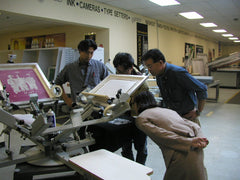The final step in the screen printing process is curing. It is a very important step. Ink must be cured for it to set. If the ink is not set it will deteriorate quickly by cracking and chipping. There are many methods for curing the ink and this helpful guide will show you many different ways to cure ink.
What is curing?
In the context of screen printing we will say that curing is a chemical process that hardens a substance. It becomes tough and stable. Plastisol Ink is basically liquid plastic. So to get it to stay on a shirt it must harden, otherwise it will drip all over the shirt. The fundamental process of curing ensures the stability of the ink.
Curing typically involves heating a substance to a very high temperature and as it approaches this temperature the substance gets harder and harder. There are three main types of ink and their curing temps are similar, but not exactly the same. Plastisol ink cures between 300° - 330°F. Water-based ink cures at 300° - 320°F. Discharge ink cures at 320°F.
All that being said there are low-cure plastisol inks. These inks cure at 275° - 280°F. There are a number of benefits to low-cure plastisol inks. Some fabrics are difficult to print on with a higher temperature. It may scorch the fabric. Lower temperatures help prevent dye migration. Polyester shirts won’t bleed if you keep the temperature lower.
Check the ink that you are going to use before you purchase it. See what temperature the ink needs to cure at. Determine if your equipment and your process can handle the method that you are going to use.
Curing With A Heat Gun
One of the cheapest ways to cure a garment is with a heat gun. It does work, but not in all cases. A heat gun is very targeted. If you are looking to cure a very small area then this may be the right tool for you. Heat guns don’t work for large prints because it is difficult to evenly heat a large print with a heat gun.
Most heat guns don’t have temperature settings, so it is difficult to tell what temperature the heat is. That being said, if it’s too hot the ink could boil. If it’s too cold then the ink may not completely cure. With a larger print it would be difficult to ensure that the entire print was cured properly.
When you use a heat gun for drying plastisol aim the heat directly over the plastisol. The garment will be ready when the ink is dry to the touch. Do not use a heat gun for water-based ink. This type of ink requires additional additives to allow it to dry. Do not use a heat gun for discharge inks.
This method of curing lends itself to small runs. You would not want to cure thousands of items with a heat gun. There are more efficient ways.
Curing With A Heat Press
This is one of the best ways to cure ink. The heat source is usually very even and stable. Many heat presses will have digital temperature readouts that will let you know where you stand in regards to heat. Heat presses are excellent for shops as well. Check out our guide on choosing the perfect screen press.
When curing plastisol with a heat press set the temperature of the press first. Set the temperature 30° higher than the curing temperature of the ink. Lay the shirt on the platen with the design up. Lay a Teflon sheet on top of the design. Then press the heat press and leave it pressed for 10 - 20 seconds. Remove the Teflon and the shirt. Test the shirt by stretching it at the design. If it doesn’t crack the ink is cured.
You can heat press water-based inks as well. The process is slightly different. Set the temperature of the heat press to 330°. Lay a Teflon sheet on top of the design. Then pull the press down but not completely. It needs to be low enough to heat the ink, but do not press it in. Let it hover above the design for 10 - 20 seconds. This will evaporate the water in the water-based ink. Then after the water is evaporated you press completely down with moderate pressure. Hold the press there for 30 - 40 seconds. Open the press. Remove the Teflon sheet and then the shirt.
Discharge ink cannot be cured with a heat press.
Curing With A Flash Dryer
One of the most popular methods for curing the ink is to use a flash dryer. Flash dryers are simple to use and a great option for beginners. Essentially, a flash dryer is very similar to a heat gun, but is much more consistent.
So the shirt will remain on the platen after you have printed. Then you swing the platen with the shirt on it underneath the flash dryer. This gives the garment an even blast of heat. Check the temperature of the room before you start and adjust the temperature of the flash dryer accordingly. A flash dryer in a cold room can take longer to cure ink. A flash dryer in a warm room has the potential to warp the platen.
The flash dryer needs to remain around 3 inches above the garment. The flash dryer will heat from the top, but it will also heat from the platen as well. The first step is to print the shirt and remove it from the platen. Then place the shirt on top of the platen and move the platen over the shirt. Using a temperature gun aim the laser in the center of the ink. When the temperature is the same as the cure temp remove the flash unit.
With a flash dryer being similar to a heat gun there is still the same issue with drying water-based ink. An additional additive must be added to the ink to allow it to cure.
Discharge ink cannot be cured with a flash dryer.
Curing With A Conveyor Dryer
A conveyor dryer is great for high-volume orders. Multiple shirts can be cured at once with a conveyor dryer. Production will increase with multiple cures. Before drying starts adjust the speed of the belt. The heat must be adjusted, also.
When the conveyor dryer is ready place your shirts one at a time on the conveyor. Before getting too far into production check to make sure that your printer is completing its curing appropriately. Check the ink on one shirt to see if it is cured. If it isn’t, then readjust the temperature or the speed of the dryer.
If using a water based ink, ensure that the dryer has forced air. If the dryer does not have forced air then an additive will need to be added to the ink.
Discharge ink can be cured with a conveyor dryer. However, because of the water that is in the discharge ink a forced air dryer must be used.
Check The Ink to See if it Cured
The ink must be cured. There is no way around it. If the ink is not cured the ink will end up cracked and chipping. You will have returns. So make sure it is cured. You must test your prints again and again. You have no option but to get it right. As previously stated, check to see if plastisol inks are cured by stretching the shirt. While you are stretching the shirt you need to check for cracks on the surface. The ink will either stretch, crack or film split. If it stretches you did a good job.
Cracking and film split look similar, but they are not the same thing. Cracking means the ink did not cure. Film split means the ink is stretched well beyond its capabilities. The difference is that cracking ink will be all over the printing. It will be jagged. Film split will not be as prevalent.
Even though you stretch the shirt, all this really proves is that the top layer of ink has been cured. The bottom layer may not be cured. Wash the shirt a few times and see if it stands up to the washing machine. If it looks horrible then it didn’t cure well. Test. Test. Test.
The Final Word on Curing Ink
It is easy to think that this is simply drying the ink. It is much more than that. It is part of an overall process. It is important. This may be the most important part. It is the final step. Customers are relying on a screen printer to ensure a great product. It cannot be stated enough, you need to test. Check the temperatures. Check that the underlayers are cured. If you don’t do this you will have problems.




Leave a comment